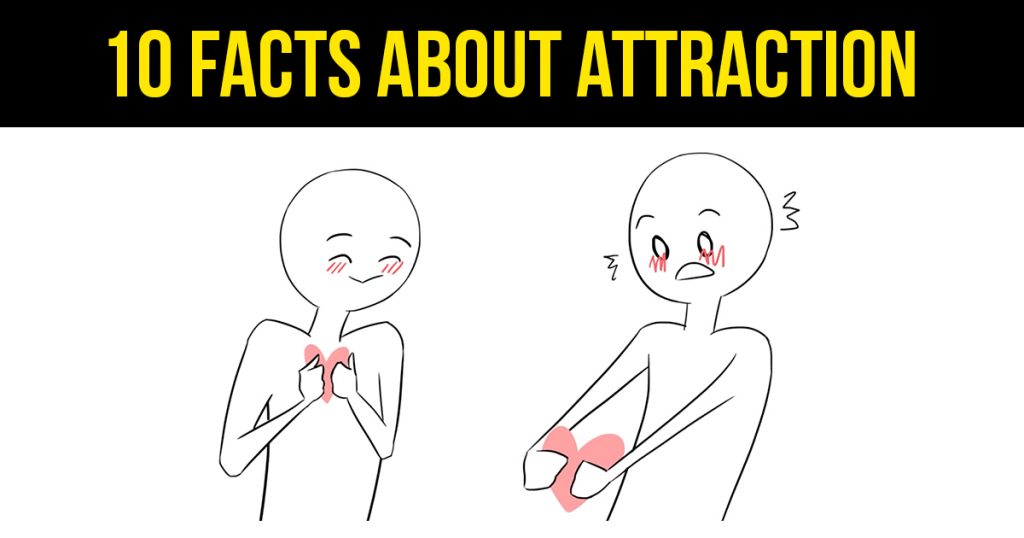10 Psychological Facts About Attraction

We all know the stages of a relationship: the first meeting, the dating, the becoming official, moving into together, and eventually cohabiting or marriage.
However, what is it that draws us to someone? Is it how they look? Their smile? The confidence they exude?
For years, researchers have studied the science of attraction. Luckily, they provided us with a loose guideline as to why we are attracted to someone.
Below are ten psychological facts about attraction.
1. Scent plays a larger role than you think
In A Search for Lost Time, Marcel Proust points out how olfactory stimuli recalls memories. For example, the smell of a cookie immediately evokes feelings of warmth and childhood. However, smells also influence attraction.
When you think of attraction, you might immediately think of pheromones. Pheromones are the reason for the success of the perfume industry. Though pheromones can help us identify gender, they are not the only biochemical reactions that affect attraction.
The empirical proof for attraction came from a study involving mice and transplant tissue rejection. The body accepts or rejects an organ depending on how analogous it is to its own cells, and it is the immune system’s job to identify the transplanted cells. In the case of an intruder, the immune system is meticulous. If the transplanted cell is rejected, the immune system creates antibodies against it. It also stores that cell’s genetic information for future use. This step involves a specific genetic code, MHC, which also plays a role in attraction.
Major histocompatibility complex or MHC (HLA in humans) genes function as the eyes of the immune system. They alert the body when a past invader has entered. These genes are co-dominant, which increases your resistance to more than one disease. Thus, ensuring survival and attraction is about survival. Researchers proved this point when female mice chose a suitor based on the MHC genes she found by smelling urine.
Similarly, a study led by Claus Wedekind at the University of Bern in Switzerland found the MHC difference secreted through men’s apocrine affected women’s attraction ratings. Results showed that women preferred men with differing MHC profiles. Most preferred candidates whose smell reminded them of an ex-boyfriend. Despite the high rating of males with MHC dissimilar genes, some were rated lower than others. This rating could be because odor is a useful indicator of genetic diseases, such as schizophrenia and diabetes.
Despite the numerous studies linking smell and attraction, there have been no studies to see if men can also sniff out genetically suitable partners.
2. Sound, too
Sexual attraction involves sound as well as visuals. Though pop culture dictates that women with high-pitched voices are deemed more feminine and thus attractive, science dictates otherwise. Susan Hughes and her team of researchers at Albright College found that, regardless of gender, people were more attracted to those who had huskier or sexier voices. Researchers found that people often lower their voice to indicate a higher level of physiological arousal, which may be why we find huskier voices more attractive.
Music can not only set the mood, but it can also help increase attraction. Scientific findings show that music can increase dating desirability.
3. Facial symmetry may play a role
Though beauty standards vary depending on culture and period, facial symmetry is a constant barometer of beauty. It is a signal of health. Preferring a symmetrical face is an evolutionary vestige –a screening method that ensures the safety and longevity of future offspring. Although a perfectly symmetrical face is impossible, the sum of tiny imperfections and how they balance each other is what creates good facial symmetry. However, overexpression of those imperfections indicates an ongoing disadvantage or potential handicap.
Interestingly enough, facial symmetry also affects friendships.
4. Signs of health are important
Apart from facial symmetry, other physiological factors influence attraction. Most people are unwillingly attracted to those who look healthy or fertile. This category is not only restricted to hip-waist-shoulder ratios and facial structure. Other physical cues signal youth and vitality. A myriad of studies shows that men are more attracted to women who appear healthier– have brighter eyes, clearer skin, and full lips. It is no wonder that the beauty industry is so lucrative–most products are designed to make women appear younger.
Males are not the only ones who seek out these physical cues. Unconsciously, women also look for signifiers of health, such as athleticism, broad shoulders, and narrow hips.
5. Similarity
Thankfully, our evolutionary needs do not dictate everything. Personality also plays a factor in attraction.
Contemporary wisdom dictates that opposites attract. While it may be true in some cases, studies have shown that most people are attracted to those who are similar. Not alike, but similar.
A meta-analysis conducted in 2008 by Montoya, Horton, and Kirchner found that actual similarity and perceived similarity affected attraction. Participants were asked to list similarities between themselves and their partners. Researchers collected the data and found that those who shared similarities or believed they shared similarities with their partner, found their partner more attractive. An important caveat to the study was that while actual similarity played a role in the early development of the relationship, it had no importance in later development. On the other hand, perceived similarity played a role in the later stages.
To further explain the link between attraction and similarity, Norton, Frost, and Ariely’s (2007) article should be taken into account. This article highlights why attraction levels fluctuate throughout the development of a relationship. During the early stages of courtship, the partner is considered attractive because their date perceives them as similar. However, to maintain the relationship, their partner’s perceived similarities need to be confirmed.
6. Self-assurance can win people over
When someone with a confident aura walks in, heads turn. They have an air of je ne sais quoi about them that you might admire them and might even consider attractive. However, self-confidence is not the key to attraction. What you are attracted to is not confidence, but rather how self-assured or self-aware they are. Though society often conflates self-awareness and self-confidence, they are slightly different.
Confidence comes from the Latin root fidere, which means to trust. This trust is rooted in your abilities and aptitude to rise above a challenge. Though it is a great virtue to have, it does not elicit attraction. Self-awareness, on the other hand, is the confidence or trust in who you are regardless of how you measure up compared to others. It denotes that you are comfortable with yourself. This nuance is what can make you seem more attractive than others.
Those who are self-assured walk the narrow ledge between self-doubt and arrogance. Someone self-assured does not feel the need to compete or belittle others and is more willing to compliment others.
Though having a bit of self-confidence can do no wrong, it can lead us to believe things about ourselves that are not true. It can sometimes intimidate others. Self-assurance, on the other hand, allows others to feel comfortable around you. Comfortable enough to approach you.
7. Eye contact
Maintaining eye contact also plays a role in attraction. In 1989, researchers Kellerman, Lewis, and Laird set out to explore the effects of mutual eye contact on relationships. They randomly paired participants into opposite-sex couples and asked them to gaze at their hands, eyes, or count the number of blinks. The results indicated that those who maintained eye contact reported stronger feelings of affection, passionate love, dispositional love, and liking for their partner.
Making eye contact indicates intentionality and interest. It lets the other person know that you are alert and focused. Studies show that making eye contact initiates a process of self-other merging, where you begin to see the other person as more similar to yourself. This, in turn, increases attraction.
Additionally, maintaining eye contact also activates multiple areas in the brain. You become aware of the other person’s consciousness and agency. Try staring into the eyes of a painting. After a while, you begin to imagine that it is staring and judging you as well.
Next time you are on a date, maintain eye contact. You might get a second date.
8. Proximity
Another factor that influences attraction is proximity. Have you ever noticed that someone becomes more attractive the more time you spend with them? Strange, isn’t it. Well, this phenomenon is known as the exposure effect.
The exposure effect explains why were are attracted to those who immediately near us– they feel familiar. A study conducted in 2006 surveyed married and long-term couples and found that 38% of these couples became acquainted through the same job, school, or church. This theory correlates with our evolutionary tendency to gravitate towards the familiar.
9. Mirroring
Body language can reveal a lot about the level of attraction. People who are attracted to each other unconsciously mimic each other’s movements. This is called mirroring. Scientifically, it is called limbic synchrony. Mirror neurons in our brain are responsible for setting specific behavioral patterns that match those who we are interested in or connected to. From an evolutionary standpoint, it was beneficial for us to be in sync with those around us because it ensured survival.
Mirroring is really evident in couples. For example, they may cross their legs at the same time or yawn simultaneously. Mirroring is a sign of empathy, trust, and connection.
10. Blushing
One of the last factors for attraction is blushing. Blushing can mean many different things. It can mean that you are feeling shy, frustrated, or self-conscious, but in the context of dating, it means that you are interested.
An emotional response triggers a surge of chemicals, like adrenalin, causing you to blush. Not only does it signal to your date that you are more than interested, but it has evolutionary roots. It mimics post-coital flush that signals fertility. Thus, making you more attractive.
Attraction is the first step in a relationship. It helps us navigate the dating world to find someone with who we can enter a relationship. There are subtle cues our body sends out to express attraction and also to attract others.
Let us know in the comments below if you what other signs of attraction you might have noticed.
Additional Sources
Burriss, Robert P. “Does Beauty Signal Health?” Psychology Today, 27 Nov. 2018, www.psychologytoday.com/us/blog/attraction-evolved/201811/does-beauty-signal-health.
Carey, Bjorn. “The Rules of Attraction in the Game of Love.” LiveScience, Purch, 13 Feb. 2006, www.livescience.com/7023-rules-attraction-game-love.html.
Furlow, Bryant F. “The Smell of Love.” Psychology Today, Sussex Publishers, 1 Mar. 1996, www.psychologytoday.com/us/articles/199603/the-smell-love.
Lentz, Cheyenne. “Why You’re Attracted to Certain People, and Not Others.” Insider, Insider, 29 Nov. 2018, www.insider.com/why-are-we-attracted-to-certain-people-2018-11.
Paris, Wendy. “Why We Want Who We Want.” Psychology Today, Sussex Publishers, 4 July 2017, www.psychologytoday.com/us/articles/201707/why-we-want-who-we-want.
Steber, Carolyn. 11 Scientific Facts To Know About Attraction That Might Surprise You. 2 May 2017, www.bustle.com/p/11-scientific-facts-to-know-about-attraction-that-might-surprise-you-51961.
Stokes, Rebecca Jane. “Does Facial Symmetry Make You More Attractive? – PHOTOS.” Bustle, Bustle, 22 Sept. 2014, www.bustle.com/articles/40907-does-facial-symmetry-make-you-more-attractive-photos.
Tan, Chen. “The Uncanny Psychology Behind Scent and Attraction.” Medium, Thrive Global, 4 Apr. 2017, medium.com/thrive-global/the-uncanny-psychology-behind-scent-and-attraction-6e06f110de6e.
Verhaeghe, J et al. “Pheromones and their effect on women’s mood and sexuality.” Facts, views & vision in ObGyn vol. 5,3 (2013): 189-95.



Responses